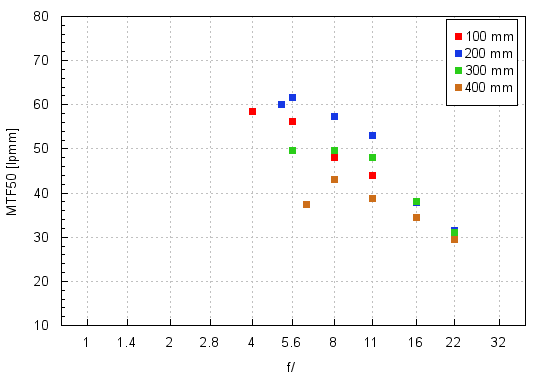Panasonic Leica DG Vario-Elmar 100-400 mm f/4.0-6.3 ASPH. POWER O.I.S.
4. Image resolution
Let’s glance at the graph below and check how the tested lens compares in the frame centre at 100, 200, 300 and 400 mm.

Please Support UsIf you enjoy our reviews and articles, and you want us to continue our work please, support our website by donating through PayPal. The funds are going to be used for paying our editorial team, renting servers, and equipping our testing studio; only that way we will be able to continue providing you interesting content for free. |
- - - - - - - - - - - - - - - - - - - - - - - - - - - - - - - - - - - - - - - - - - - - - - - -
It is clear our fears voiced in the introduction are confirmed. The tested lens is able to reach best results when it is the fastest so at 100-200 mm. The 60 lpmm we got for such settings is a good value, typical for dark zoom instruments; it’s enough to remind here that the Olympus M.Zuiko Digital 12–50 mm f/3.5–6.3 ED EZ with a similarly fast aperture generated results on the same level.
The 300 mm focal length, even at the maximum relative aperture, still allows you to enjoy an image of acceptable quality. In perfect accordance with our expectations the slowest maximum focal length is also the biggest problem – only after employing apertures close to f/8.0 you can brush against images of more or less decent quality. At other apertures the resolution is simply weak – it’s clear you cannot cheat physics laws…
Now let’s check the edge of the frame with help of the graph below.

Similarly and again in perfect accordance with our expectations the short end of the focal range fares the best here – the lens doesn’t have to be ashamed of the image quality in that place. Even at the maximum relative aperture you are able to take completely satisfactory photos.
Unfortunately the results at the longest focal lengths can be called only weak…
What could be said…the performance is not that bad for a lens with such parameters as laws of physics don’t allow it to achieve anything more. If you can accept such limitations the results of the Panasonic 100-400 mm don’t disappoint. Even Leica optics specialists aren’t magicians so you shouldn’t expect any miracles.
Traditionally we end this chapter by presenting crops taken from photos of our resolution testing scene in the frame centre. It’s worth reminding that these are JPEG files straight from the camera which were saved along RAW files, described above.
| E-PL1, JPEG, 200 mm, f/5.6 |
 |
| E-PL1, JPEG, 400 mm, f/6.3 |
 |






